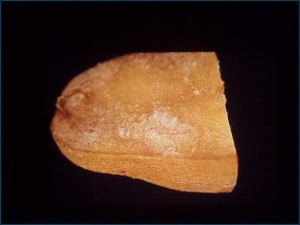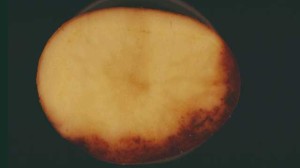Be Vigilant Against Late Blight In 2015
The 2014 season will be remembered as one of the worst for potato late blight in recent memory. Almost all of the potato production regions in the U.S. received several lengthy periods of weather that were ideal for late blight development.

Seen here is the late blight organism sporulating on a potato seed piece. Photo Credit: Phil Nolte
We even had the disease occur in the high desert production regions of Idaho this year, which is something that does not normally happen. We scrambled to get the crop treated in the field, kill the vines, and get the crop harvested. Now that potatoes are securely put away in storage, we can relax, right? Well … not really.
Maintain Proper Storage
Storage facilities in areas where late blight occurred should be carefully monitored all winter to ensure there aren’t any decay problems occurring due to late blight. Be especially vigilant with crops produced in fields that were known to have had late blight in them. One fact to keep in mind: Some of the worst tuber blight infestations have occurred in fields that had only light foliar infection.
The tuber phase of late blight is certainly bad enough, but there is greater danger. Tuber tissues invaded by late blight have a dry, corky, reddish-brown appearance and this decay also progresses relatively slowly. Tuber diseases such as pink rot and pythium can invade through late blight lesions. However, some of the most serious storage problems occur because the ever-present soft rot bacterium can also readily invade late blight-infected tubers.
Unlike late blight, soft rot and pythium decay both progress rapidly and can get out of hand in a very short time. Stored crops known to have late blight will require high volumes of air all winter to ensure proper storage. Remember, long-term storage may not be an option.

Typical symptoms of late blight tuber infection include a dry, corky, reddish-brown appearance. Photo credit: Phil Nolte
Continue Monitoring
One of the greatest dangers of a bad late blight year is the very real possibility that the following season will also be difficult. When late blight has been in the area, the likelihood that the disease will overwinter in multiple locations, and therefore be able to give the disease an early start the following season, is greatly increased.
How does late blight overwinter? Cull piles are one of the most important sources of inoculum and you will have to pay extra attention to proper cull pile management next season. There is also a strong possibility that infected volunteers from the 2014 crop could emerge in fields that produced potatoes and provide an additional source of inoculum for the new production year.
Another major source of over-wintering inoculum for the initiation of a new cycle of infection is late blight-infected seed potatoes. Many of our nation’s seed-producing areas were also exposed to late blight during the 2014 season.
For this reason, the use of seed piece treatments that are active against late blight is highly recommended next season for all producers. In fields planted with seed that is known or suspected to be infected, late blight management programs should start early, shortly after emergence.
With all of this in mind, it stands to reason that careful monitoring of next year’s crop for late blight will be necessary, especially if your production area is subjected to the wet conditions that favor the development of this dreaded disease.










